
Corporate sales activities often rely on printed materials, incurring costs with each production. Recently, on-demand printing has emerged as a cost-effective solution. In this guide, we explore the ins and outs of on-demand printing, including its advantages, suitable applications, and key considerations.
Overview of On-demand Printing
On-demand printing leverages digital technology to produce materials as needed, offering rapid turnaround times and cost-effective customization options. It caters to various needs, from small batch printing to personalized marketing collateral.
Situations Where On-Demand Printing Excels
On-demand printing is utilized across various scenarios where flexibility, speed, and cost-effectiveness are paramount. Here are some key instances:
- Customized Marketing Materials
- Variable Data Printing
- Small Batch Production
- Quick Turnaround Projects
- Prototype Development
- Just-in-Time Inventory
The Advantages of On-Demand Printing
On-demand printing offers cost savings, flexibility, speed, customization, and sustainability, making it a highly advantageous solution for modern businesses across various industries.
- Flexibility
- Speed
- Customization
- Reduced Inventory
- Prototype Testing
- Scalability

Let’s take a closer look at the benefits of each.
Low-cost, small-lot printing
On-demand printing relies on digital printing technology, which eliminates the need for expensive printing plates used in traditional offset printing. Digital printers can directly print from digital files, bypassing the plate-making process, which significantly reduces setup costs. Additionally, unlike traditional printing methods that often require a minimum print run to be cost-effective, on-demand printing allows for the printing of small quantities without incurring additional expenses. This means businesses can print only the quantity they need at any given time, reducing waste and costs associated with excess inventory.
The combination of digital printing technology, no minimum print runs, reduced overhead, efficient workflow, and variable data capabilities enables on-demand printing to provide cost-effective solutions for small batch printing needs.
Various Types of Variable Data
On-demand printing has the capability to handle various types of variable data, allowing for customized and personalized printed materials. Some examples of variable data that can be accommodated include:
- Personalized Text
- Variable Image
- Unique Barcode or QR code
- Customized Graphics
- Sequential Numbering
- Variable Pricing
Utilizing On-Demand Printing for Test Marketing
On-demand printing offers the advantage of being able to print only the required quantity at the necessary timing, making it suitable for test marketing purposes. For instance, by printing small quantities of flyers with three different designs using on-demand printing, businesses can assess customer reactions. Subsequently, the most effective design can be identified, and then produced in large quantities using offset printing.
The Disadvantages of On-Demand Printing
While on-demand printing offers flexibility, speed, and convenience, it may not always be the most cost-effective or suitable option for every printing project, particularly those requiring large quantities or specialized finishes.

Limited Economies of Scale
On-demand printing does not benefit from economies of scale in the same way as offset printing. As a result, the cost per unit may not decrease significantly as the quantity increases, making it less economical for large print runs.
Printing quality of on-demand printing
Resolution and Detail
Offset printing typically offers higher resolution and finer detail compared to on-demand printing. This is because offset presses can achieve finer dot patterns and better color registration, resulting in sharper images and text.
Color Accuracy
Offset printing often provides more accurate color reproduction and consistency compared to on-demand printing. Offset presses can use precise ink mixing and color calibration techniques to match colors accurately, resulting in vibrant and true-to-life prints.
Paper Selection
Both on-demand and offset printing can produce high-quality prints on a wide range of paper stocks. However, offset printing may offer more options for specialized papers and finishes, such as textured or metallic papers, which can enhance the overall appearance of printed materials.
Consistency Across Runs
Offset printing tends to offer more consistent results across multiple print runs compared to on-demand printing. Once the press is properly set up, offset presses can maintain consistent color and image quality throughout long print runs, whereas on-demand printing may exhibit more variability from run to run.
Use of on-demand printing and offset printing
Use on-demand printing for small to medium quantities, quick turnaround times, and projects requiring variable data printing. On the other hand, choose offset printing for large quantities, high print quality, a wide range of paper options, and cost-effectiveness for long print runs.
Points to Note When Submitting Printing Data
When requesting on-demand printing services, it’s important to consider the following data handling precautions:
- File Format Compatibility
- Resolution and Bleed
- Color Mode and Profile
- Font and Text
Let’s take a closer look at each of these precautions.
File Format
Ensure that your files are in compatible formats for on-demand printing, such as PDF, EPS, or ai. Check with the printing provider for specific requirements regarding file formats and compatibility. If you’re unable to modify the files yourself, PDF format is typically the best option
Resolution and Bleed
Provide high-resolution files with appropriate bleed settings to ensure crisp and accurate printing results. Low-resolution files may result in pixelation or blurriness, while inadequate bleed can lead to white borders or trimming issues.
Color Mode and Profile
Specify the correct color mode (CMYK for print) and color profile for your files to ensure accurate color reproduction. Avoid using RGB color mode, as it is intended for digital display and may result in color discrepancies in print.
Fonts and Text
Embed all fonts or convert text to outlines to avoid font substitution issues. Ensure that text is legible and properly aligned within your design to prevent readability issues in the printed materials.
Consultation for Printing Needs
For arranging printed materials for your Japanese branches, clients, exhibitions, and events, consult with our team at Modern.
